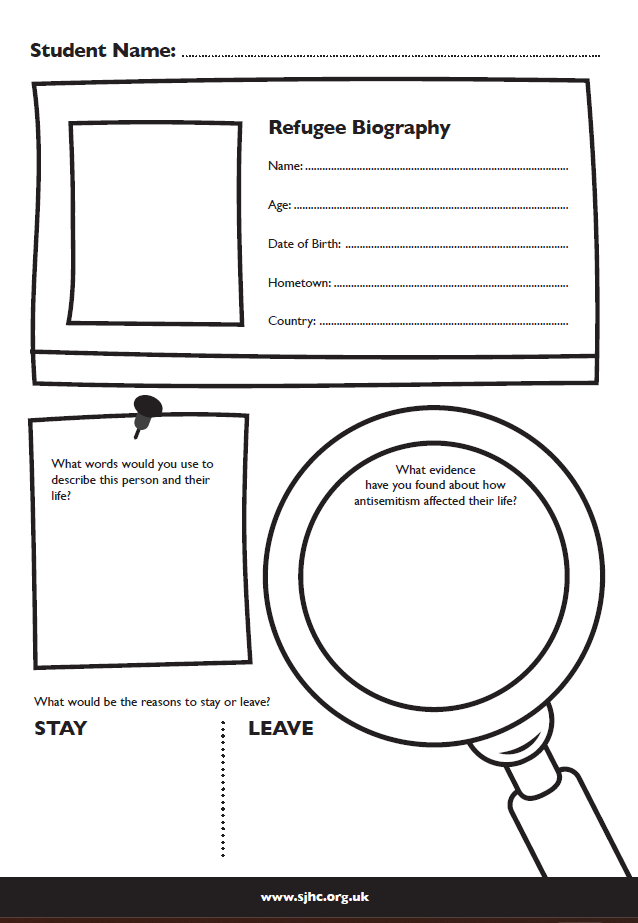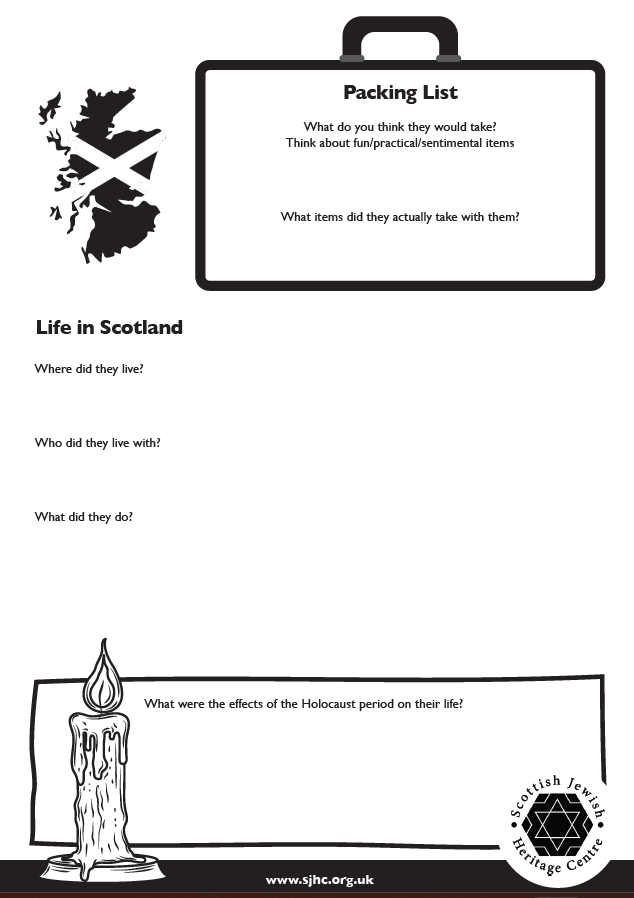Our ‘Refugee Stories’ Learning kits were the first resource we developed at the SJHC, for the launch of the Centre in 2021. The aim was to tell Scottish stories using strong primary resource material from the collections of the Scottish Jewish Archives Centre. Pupils would be able to find out about the real-life experiences of a refugee from Nazi Europe who found a safe haven in Scotland.

Using facsimile documents, photographs and personal testimonies, students learn about life under the Nazi regime, escape to Scotland, and the challenges of starting over. Material from three individuals was used – Dorrith Sim (Oppenheim), Hilda Goldwag and Ernst Marchand. During the development phase, we consulted with experts in Holocaust education, and the kits were designed to be age-appropriate for primary six to secondary two level, telling stories of rescue and survival.
Each kit differs due to the material available but all are based around the same basic structure :
- Who is the person?
- What is their life like in Germany/Austria?
- What happens to make them come to the UK?
- What is their life like in Scotland?
- What happens after the war?
The three kits each touch upon slightly different themes, although all discuss antisemitism, persecution, democracy and the refugee experience.
Ernst’s story begins in Germany, where he lived with his mother Irene. He was 9 years old in May 1939 when he and Irene arrived in the UK on Irene’s UK Government visa. They came to Glasgow where Irene became the matron of the refugee hostel set up for boys next door to the synagogue. Additional themes discussed are anti-Jewish laws and reconciliation. The session includes a very powerful oral history recording from Ernst.
Hilda Goldwag lived in Austria with her widowed mother. A talented artist, she escaped to safety in April 1939, thanks to the Domestic Bureau in Scotland who secured her a UK visa. Living first in Edinburgh, Hilda later lived in a flat very close to Garnethill Synagogue and lived in Glasgow for the rest of her life. Additional themes covered include the anschluss and the journey to British citizenship.
Dorrith Oppenheim was just 7 years old when she left Germany on a Kindertransport in July 1939. Dorrith lived in Edinburgh with her adoptive parents and later married Andrew Sim and raised her family in Ayrshire. She wrote ‘In My Pocket’, an illustrated book for children that is based on her experience of the Kindertransport. Kristallnacht and the Kindertransport are the additional subjects included in Dorrith’s story.

Since 2021, the kits have been reviewed and refined several times. A very useful addition to the sessions has been the development of a structured worksheet, which gives the pupils a more defined focus for the sessions and also ensures that they are able to take home a thorough record of the story of the kit’s subject. In addition to recording biographical information about the person, students are prompted to notice evidence of antisemitism and to reflect on the effects of the Holocaust on the person’s life.


In order to make the sheet a good fit for each kit, the three kits were reviewed and material added to ensure that each question made sense and could be fully answered. We also took the opportunity to add in some contemporary photographs of 1930s Germany and Austria to demonstrate some of the discrimination faced in the home countries of the kit subjects, if this wasn’t clear in the archive material or personal testimony. The images used came from the collection of the Wiener Holocaust Library, and have proven to be a brief and impactful way to show the larger political picture at the time.
In order to ensure the visit is as relevant as possible for pupils and teachers, we have mapped the session to ILOs, specifically that students will:
- Develop awareness that different types of evidence can help them to find out about the impact of WWII on Jewish refugees and their families (SOC 0-01a).
- Compare aspects of people’s daily lives in the past with their own by using primary source material belonging to the individual who became a refugee in Scotland (SOC 1-04a).
- Assess the impact on Jewish people of the expansion of power and influence of the Nazi government by tracing the development of antisemitic laws. They will also empathise with the experiences of those involved by analysing the effects this had on the refugees (SOC 4-06b).

The suggested time for a visit is 2 hours, for a class size of up to 32 pupils. The group is divided into two, with half enjoying a shorter focussed tour of synagogue while the other half do the Learning Kit, and then swapping over.
If you would like to find out more about the school visits or the travel bursaries, please click the button below.

